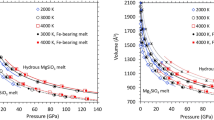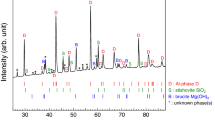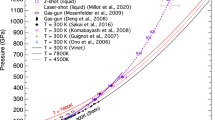Abstract
Silicate liquids play a key part at all stages of deep Earth evolution, ranging from core and crust formation billions of years ago to present-day volcanic activity. Quantitative models of these processes require knowledge of the structural changes and compression mechanisms that take place in liquid silicates at the high pressures and temperatures in the Earth’s interior. However, obtaining such knowledge has long been impeded by the challenging nature of the experiments. In recent years, structural and density information for silica glass was obtained at record pressures of up to 100 GPa (ref. 1), a major step towards obtaining data on the molten state. Here we report the structure of molten basalt up to 60 GPa by means of in situ X-ray diffraction. The coordination of silicon increases from four under ambient conditions to six at 35 GPa, similar to what has been reported in silica glass1,2,3. The compressibility of the melt after the completion of the coordination change is lower than at lower pressure, implying that only a high-order equation of state can accurately describe the density evolution of silicate melts over the pressure range of the whole mantle. The transition pressure coincides with a marked change in the pressure-evolution of nickel partitioning between molten iron and molten silicates, indicating that melt compressibility controls siderophile-element partitioning.
This is a preview of subscription content, access via your institution
Access options
Subscribe to this journal
Receive 51 print issues and online access
$199.00 per year
only $3.90 per issue
Buy this article
- Purchase on Springer Link
- Instant access to full article PDF
Prices may be subject to local taxes which are calculated during checkout




Similar content being viewed by others
References
Sato, T. & Funamori, N. Sixfold-coordinated amorphous polymorph of SiO2 under high pressure. Phys. Rev. Lett. 101, 255502 (2008)
Meade, C., Hemley, R. J. & Mao, H. K. High-pressure x-ray diffraction of SiO2 glass. Phys. Rev. Lett. 69, 1387–1390 (1992)
Benmore, C. J. et al. Structural and topological changes in silica glass at pressure. Phys. Rev. B 81, 054105 (2010)
Rigden, S. M., Ahrens, T. J. & Stolper, E. M. Densities of liquid silicate at high pressures. Science 226, 1071–1074 (1984)
Agee, C. B. Crystal-liquid density inversions in terrestrial and lunar magmas. Phys. Earth Planet. Inter. 107, 63–74 (1998)
Ohtani, E. & Maeda, M. Density of basaltic melt at high pressure and stability of the melt at the base of the lower mantle. Earth Planet. Sci. Lett. 193, 69–75 (2001)
Funamori, N., Yamamoto, S., Yagi, T. & Kikegawa, T. Exploratory studies of silicate melt structure at high pressures and temperatures by in situ X-ray diffraction. J. Geophys. Res. 109, B03203 (2004)
Asimow, P. D. & Ahrens, T. Shock compression of liquid silicates up to 125 GPa: the anorthite–diopside join. J. Geophys. Res. 115, B10209 (2010)
Hirose, K., Fei, Y., Ma, Y. & Mao, H.-K. The fate of subducted basaltic crust in the Earth’s lower mantle. Nature 397, 53–56 (1999)
Perrillat, J.-P. et al. Phase transformations of subducted basaltic crust in the upmost lower mantle. Phys. Earth Planet. Inter. 157, 139–149 (2006)
Ricolleau, A. et al. Phase relations and equation of state of a natural MORB: implications for the density profile of subducted oceanic crust in the Earth’s lower mantle. J. Geophys. Res. 115, B08202 (2010)
Sato, T. & Funamori, N. High-pressure structural transformation of SiO2 glass up to 100 GPa. Phys. Rev. B 82, 184102 (2010)
Yarger, J. L. et al. Al coordination changes in high-pressure aluminosilicate liquids. Science 270, 1964–1967 (1995)
de Koker, N. Structure, thermodynamics, and diffusion in CaAl2Si2O8 liquid from first-principles molecular dynamics. Geochim. Cosmochim. Acta 74, 5657–5671 (2010)
Sun, N., Stixrude, L., de Koker, N. & Karki, B. B. First principles molecular dynamics simulations of diopside (CaMgSi2O6) liquid to high pressure. Geochim. Cosmochim. Acta 75, 3792–3802 (2011)
Karki, B. B., Bhattarai, D. & Strixrude, L. First-principles simulations of liquid silica: structural and dynamical behavior at high pressure. Phys. Rev. B 76, 104205 (2007)
Murakami, M. & Bass, J. D. Evidence of denser MgSiO3 glass above 133 gigapascal (GPa) and implications for remnants of ultradense silicate melt from a deep magma ocean. Proc. Natl Acad. Sci. USA 108, 17286–17289 (2011)
Eggert, J. H., Weck, G., Loubeyre, P. & Mezouar, M. Quantitative structure factor and density measurements of high-pressure in diamond anvil cells by x-ray diffraction: argon and water. Phys. Rev. B 65, 174105 (2002)
Sanloup, C., Gregoryanz, E., Degtyareva, O. & Hanfland, M. Structural transition in compressed amorphous sulfur. Phys. Rev. Lett. 100, 075701 (2008)
Stixrude, L. & Karki, B. Structure and freezing of MgSiO3 liquid in Earth’s lower mantle. Science 310, 297–299 (2005)
Sanloup, C. et al. Structure and density of molten fayalite at high pressure. Geochim. Cosmochim. Acta 118, 118–128 (2013)
Labrosse, S., Hernlund, J. W. & Coltice, N. A crystallizing dense magma ocean at the base of the Earth’s mantle. Nature 450, 866–869 (2007)
Lee, C.-T. A. et al. Upside-down differentiation and generation of a ‘primordial’ lower mantle. Nature 463, 930–933 (2010)
Thibault, Y. & Walter, M. J. The influence of pressure and temperature on the metal-silicate partition cofficients of nickel and cobalt in a model C1 chondrite and implications for metal segregation in a deep magma ocean. Geochim. Cosmochim. Acta 59, 991–1002 (1995)
Li, J. & Agee, C. B. Geochemistry of mantle–core differentiation at high pressure. Nature 381, 686–689 (1996)
Ohtani, E. & Yurimoto, H. Element partitioning between metallic liquid, magnesiowustite, and silicate liquid at 20 GPa and 2500°C: a secondary ion mass spectrometric study. Geophys. Res. Lett. 23, 1993–1996 (1996)
O'Neill, H. S. C., Canil, D. & Rubie, D. C. Oxide-metal equilibria to 2500°C and 25 GPa: implications for core formation and the light component in the Earth’s core. J. Geophys. Res. 103, 12239–12260 (1998)
Tschauner, O. et al. Partitioning of nickel and cobalt between silicate perovskite and metal at pressures up to 80 GPa. Nature 398, 604–607 (1999)
Siebert, J., Badro, J., Antonangeli, D. & Ryerson, F. J. Metal–silicate partitioning of Ni and Co in a deep magma ocean. Earth Planet. Sci. Lett. 321–322, 189–197 (2012)
Sanloup, C., van Westrenen, W., Dasgupta, R., Maynard-Casely, H. E. & Perrillat, J.-P. Compressibility change in iron-rich melt and implications for core formation models. Earth Planet. Sci. Lett. 306, 118–122 (2011)
Farges, F., Brown, G. E., Petit, P.-E. & Munoz, M. Transition elements in water-bearing silicate glasses/melts. Part I. A high-resolution and anharmonic analysis of Ni coordination environments in crystals, glasses, and melts. Geochim. Cosmochim. Acta 65, 1665–1678 (2001)
Keppler, H. & Rubie, D. C. Pressure-induced coordination changes of transition-metal ions in silicate melts. Nature 364, 54–56 (1993)
Dziewonski, A. M. & Anderson, D. L. Preliminary reference Earth model. Phys. Earth Planet. Inter. 25, 297–356 (1981)
Pichavant, M., di Carlo, I., Gac, Y. L., Rotolo, S. G. & Scaillet, B. Experimental constraints on the deep magma feeding system at Stromboli volcano, Italy. J. Petrol. 50, 601–624 (2009)
Mao, H. K., Xu, J. & Bell, P. M. Calibration of the ruby pressure gauge to 800 kbar under quasi-hydrostatic conditions. J. Geophys. Res. 91, 4673–4676 (1986)
Hammersley, A. P., Svensson, S. O., Hanfland, M., Fitch, A. N. & Hausermann, D. Two-dimensional detector software: from real detector to idealised image or two-theta scan. High Press. Res. 14, 235–248 (1996)
Nishihara, Y., Nakayama, K., Takahashi, E., Iguchi, T. & Funakoshi, K.-I. P-V-T equation of state of stishovite to the mantle transition zone conditions. Phys. Chem. Mineral. 31, 660–670 (2005)
Hosemann, R. & Bagchi, S. N. Direct Analysis of Diffraction by Matter (North-Holland, 1962)
de Koker, N. P. & Stixrude, L. Self-consistent thermodynamic description of silicate liquids, with application to shock melting of MgO periclase and MgSiO3 perovskite. Geophys. J. Int. 178, 162–179 (2009)
Acknowledgements
The research leading to these results has received funding from the European Community’s Seventh Framework Programme (FP7/2007-2013) under grant numbers 312284 and 259649 (European Research Council starting grant to C.S.). The laser heating system on beamline P02.2 is funded by the BMBF (the German Federal Ministry of Education and Research, project number 05K10RFA). We acknowledge G. Prouteau for providing the starting basalt glass, and PETRAIII for provision of synchrotron radiation facilities.
Author information
Authors and Affiliations
Contributions
C.S. devised the project, and wrote the paper with input from J.W.E.D., Z.K. and W.v.W. Also, C.S., J.W.E.D., Z.K., P.D.-S., D.M.M., N.R. and W.v.W. participated in data acquisition. Z.K. and W.M. designed the laser-heating system used during the experiments.
Corresponding author
Ethics declarations
Competing interests
The authors declare no competing financial interests.
Extended data figures and tables
Rights and permissions
About this article
Cite this article
Sanloup, C., Drewitt, J., Konôpková, Z. et al. Structural change in molten basalt at deep mantle conditions. Nature 503, 104–107 (2013). https://doi.org/10.1038/nature12668
Received:
Accepted:
Published:
Issue Date:
DOI: https://doi.org/10.1038/nature12668
This article is cited by
-
Tetracarbonates in silicate melts may be at the origin of a deep carbon reservoir in the deep Earth
Communications Earth & Environment (2023)
-
Insights into magma ocean dynamics from the transport properties of basaltic melt
Nature Communications (2022)
-
Hot dense silica glass with ultrahigh elastic moduli
Scientific Reports (2022)
-
Sulfur isotopic signature of Earth established by planetesimal volatile evaporation
Nature Geoscience (2021)
-
A comparative study on pressure-induced structural transformations in a basaltic glass and melt from Ab initio molecular dynamics calculations
Physics and Chemistry of Minerals (2021)
Comments
By submitting a comment you agree to abide by our Terms and Community Guidelines. If you find something abusive or that does not comply with our terms or guidelines please flag it as inappropriate.



